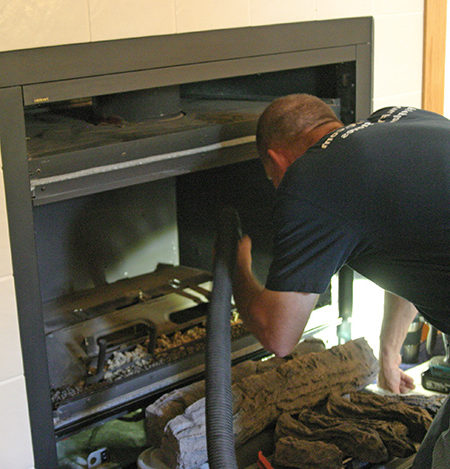 While your fireplace and wood stove are keeping your family warm and cozy during those cool days and nights, dangerous fumes and gases including soot and creosote are being vented through the chimney. Because these potentially hazardous materials can cling to walls inside the chimney, flue and components such as the log burner, the Chimney Safety Institute of America (CSIA) and the National Fire Protection Association (NFPA) recommend homeowners clean their fireplace at least once per year for proper maintenance and to prevent the risk of a chimney fire.
While your fireplace and wood stove are keeping your family warm and cozy during those cool days and nights, dangerous fumes and gases including soot and creosote are being vented through the chimney. Because these potentially hazardous materials can cling to walls inside the chimney, flue and components such as the log burner, the Chimney Safety Institute of America (CSIA) and the National Fire Protection Association (NFPA) recommend homeowners clean their fireplace at least once per year for proper maintenance and to prevent the risk of a chimney fire.
1. Safety first
Before cleaning the log burner, make sure your fireplace or wood stove is cool for at least 24 hours. This will ensure that the components including the log burner and any combustion material inside the firebox are no longer hot. If you have a gas fireplace make sure you turn off the pilot light and gas line. You can contact the gas company or your local FyrePro store for assistance if you are unsure how to do this safely.
2. Remove the grate and log burner from the firebox.
When removing the grate and log burner from the firebox, you may want to wear a pair of work gloves to avoid getting soot and creosote residue on your hands. You may also want to place these items on a protected surface or on top of newspapers for cleaning.
3. Remove the ash
Now that the ash is cool you can use a broom and dust pan to remove it from the fireplace or wood stove and deposit into a sturdy container. A vacuum with a clean bag or canister works well too. Set the ash container aside for now but do not discard yet.
4. Clean the grate and log burner.
Use a soft-bristled brush or a clean damp cloth to remove the soot, sticky creosote and other residue on the grate and burner. Many newer brushes have silicone bristles that are soft and flexible enabling you to scrub the components without scratching the surface. To remove more stubborn buildup, soak them in mild soapy water. Allow to dry thoroughly before placing them back inside the fireplace or wood stove.
5. Cleaning the firebox or wood stove
Clean the masonry walls inside the fireplace or cast iron wood stove with a damp sponge or scouring pad. Creosote is a natural by-product of wood-fuel combustion that builds up inside and this sticky residue is flammable. So you will want to avoid using any flammable cleaning agents, but mixing equal parts vinegar and distilled water in a spray bottle is an effective and natural cleaning solution that can help remove stubborn stains.
6. Cleaning the fireplace doors and safety screen
You can wipe your fireplace doors clean with the same water-vinegar solution and a clean sponge. If you have glass doors, a streak-free window cleaner and a paper towel is also an effective way to keep them clean. Also, be sure to replace your glass doors if they are chipped or cracked to prevent dangerous fumes from entering the room. The wire mesh screen is an important safety device that helps prevent sparks and burning embers from flying out of the fireplace when the fireplace doors are open. Soot and other debris that collects on the screen can be cleaned with a lint-free cloth or a sponge in mild soapy water.
 7. Annual chimney sweep and inspections
7. Annual chimney sweep and inspections
Fire safety experts highly recommend homeowners have an annual chimney sweep and inspection from a certified chimney sweep to avoid the risk of a chimney fire. The chimney sweep will clean the firebox all the way up the flue and walls inside the chimney to thoroughly remove soot, creosote and other debris that has collected inside. These experts will also check for obstructions, water or gas leaks and other damages that could result in carbon monoxide poisoning if left undetected.
8. Replace the grate and log burner
Now that your fireplace and wood stove have been cleaned you can replace the grate and log burner. But first, coat the floor of the firebox with about ¼” layer of ash. This will help reduce moisture inside the fireplace allowing your seasoned wood logs to burn more efficiently.